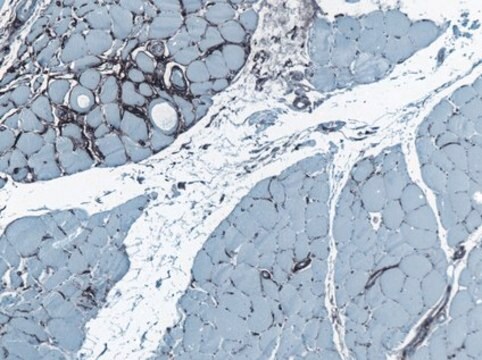CC1890
Aggrecan Interglobular Domain, Recombinant, His-tagged
Synonym(s):
Aggrecan-IGD1
About This Item
Recommended Products
biological source
human
Quality Level
form
liquid
manufacturer/tradename
Chemicon®
NCBI accession no.
UniProt accession no.
shipped in
dry ice
Gene Information
human ... ACAN(176)
General description
Main cleavage sites are indicated by <> inclusions.. The calculated Mr of the His-tagged protein is 15,493 Da.
Purity: The recombinant aggrecan interglobular domain appears as a major band at about 21 kDa in SDS-PAGE. It represents more than 90% of total protein in the preparation.
Applications: Aggrecan interglobular domain is used as substrate for aggrecanases and matrix metalloproteinases. For proteinase activity measurements, the protein is incubated with proteinase for various time intervals. Thereafter, aliquots of the incubation mixture are analyzed by SDS-PAGE or by ELISA.Upon cleavage with aggrecanases the apparent Mr of aggrecan interlobular domain in SDS-PAGE is reduced from 21 kDa to about 13 kDa. Quantitative measurement of aggrecanase cleavage requires a neoepitop antibody with specificity for the N-terminus A R G S V I L T . . . appearing upon hydrolysis. The fragment with the newly formed N-terminus is fixed by the neoepitop antibody to a microplate and quantified with an anti-His-tag antibody. In analogy, cleavage by matrix metalloproteinases can be measured with antibodies to neoepitopes appearing upon action of these enzymes.
Physical form
Storage and Stability
Legal Information
Disclaimer
Storage Class Code
12 - Non Combustible Liquids
WGK
WGK 1
Flash Point(F)
Not applicable
Flash Point(C)
Not applicable
Regulatory Listings
Regulatory Listings are mainly provided for chemical products. Only limited information can be provided here for non-chemical products. No entry means none of the components are listed. It is the user’s obligation to ensure the safe and legal use of the product.
JAN Code
CC1890:
Certificates of Analysis (COA)
Search for Certificates of Analysis (COA) by entering the products Lot/Batch Number. Lot and Batch Numbers can be found on a product’s label following the words ‘Lot’ or ‘Batch’.
Already Own This Product?
Find documentation for the products that you have recently purchased in the Document Library.
Our team of scientists has experience in all areas of research including Life Science, Material Science, Chemical Synthesis, Chromatography, Analytical and many others.
Contact Technical Service